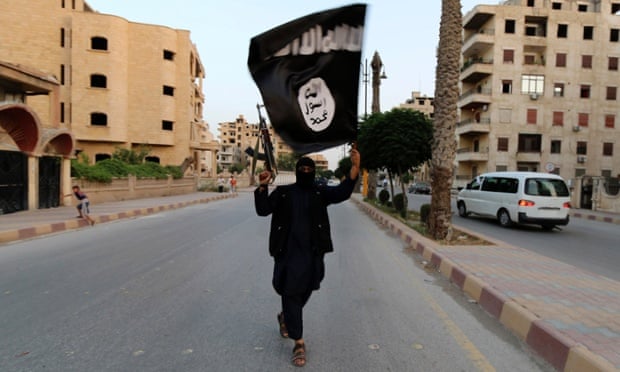Half a million people, all dressed in white, radiated from the Hotel Indonesia roundabout in central Jakarta. Protesters clogged the streets for a mile in every direction; they went all the way up to the National Monument and beyond it to the presidential palace. It was 4 November 2016, and they had come on buses, planes and on foot, from all across Java and even from some other islands, to participate in the largest Islamist demonstration in Indonesian history.
“We came to the palace to enforce the law,” said the cleric Rizieq Shihab, to rapt silence. “Desecrators of the Qur’an must be punished. We must reject the leaders of infidels,” he said, referring to Basuki Tjahaja Purnama, the Chinese-Christian governor of Indonesia’s capital city, who is known as Ahok. “If our demands are not heard, are you ready to turn this into a revolution?” “We’re ready!” screamed the crowd, breaking into huge applause. “God is great!”, they shouted. There were cries of “Kill Ahok!”
It was an odd scene in Indonesia, which is the world’s largest Muslim-majority country but is not really a “Muslim nation”. Officially, it is a multifaith country that protects six religions equally, where race and ethnicity have been tacitly elided from political discourse. An overtly Islamist political protest like this had no precedent.
In theory, the rally was organised by the Islamic Defenders Front (FPI), led by Shihab, to accuse Ahok of blasphemy against Islam and call for his removal from office. But in practice, this was less about Ahok and more about displaying the piety and political power of Muslim Indonesians – and it worked. The city shut down all its major arteries that day. At the second protest, on 2 December, the president of Indonesia himself showed up, unannounced, and prayed with them.
FPI’s campaign was more successful than it could have dreamed. The following April, Ahok lost his bid for re-election as the governor of Jakarta; a month later, at the end of a show trial, he was sentenced to two years in jail for blasphemy. The 4 November rally turned out to be a turning point for political Islam in Indonesia. The next presidential election was waged largely on the terms set by the events of 2016: both candidates played up their Islamic credentials. Today, the vice-president of Indonesia is a man who was once the nation’s chief Muslim cleric.
But Shihab is not enjoying the fruits of his labour in Indonesia. He lives, instead, in Saudi Arabia. After the Jakarta gubernatorial election, he became embroiled in a sexting scandal; when an arrest warrant was issued, he fled to Mecca. Though it is almost 5,000 miles away from Indonesia, the kingdom is a natural choice of refuge for Shihab, because his Saudi ties date back three decades. He graduated from the Islamic and Arabic College of Indonesia, or Lipia, a university in Jakarta built, funded and fully subsidised to this day by Saudi Arabia. His studies at Lipia paved the way for further education in Riyadh, where he forged enduring networks with Saudi clerics.
As the largest Muslim-majority nation and a developing, postcolonial state, Indonesia has been a prime recipient of the full spectrum of Saudi proselytisation – known as dawa, the call to Islam. And while investments peaked in absolute terms at least a decade ago, as they did in most of the Muslim world, their effects continue to reverberate. Saudi investment in Indonesia has at turns fuelled jihadists, helped consolidate the country’s leading Islamist political party and produced dozens of influential ideologues. The Saudi soft-power apparatus in Indonesia is unrivalled, including Lipia, a large embassy and a powerful, standalone “religious attache”. Saudi charity has also paid for thousands of poor students to go to school and university, and helped rebuild devastated regions such as Aceh after the Boxing Day tsunami of 2004.
The influence of Shihab’s organisation and vision is just one example of how Saudi dawa has shaped modern Indonesia. Another is the Bali bombings of 2002, which killed 202 people, mostly tourists, in the world’s most deadly terror attack after 9/11, and which woke Indonesia up to the danger of terrorism within its borders. The attacks were planned by a circle of al-Qaida-affiliated jihadists based at the al-Mukmin Islamic boarding school in Central Java, which was founded with an initial endowment from the Saudi king in 1972.
Beyond such flagship investments, an equally pervasive legacy of Saudi proselytisation in Indonesia has been the rise of virulent religious intolerance. In addition to the commonplace harassment of Christian groups and the show trial of Ahok, its most prominent Christian politician, Indonesia is also now a country where there is a national “anti-Shia” league and mobs have driven Ahmadiyya Muslims from their homes into refugee camps.
It’s not for nothing that when Barack Obama, who spent five years in Jakarta as a child, returned to Indonesia in 2011, he remarked on the “more fundamentalist, unforgiving interpretation” of Islam he now observed in the archipelago. He attributed this to Saudi influence. What Obama was picking up on was the concept of Arabisasi – ambitious in theory and even more influential in practice.
Arabisasi was one of the first Indonesian words I learned after I moved to the country in 2016. It’s a neologism meaning, as you might expect, “Arabisation”. But the concept was used in reference to a whole class of developments in Indonesia: the rise of political Islam, blasphemy prosecutions, the growing popularity of hijabs and burqas, new mosques, louder mosques, new schools, the persecution of religious minorities. Above all, it referred to the relatively new, central role for Islam in the cultural and political life of a big democracy that was, until 1998, a tightly controlled military dictatorship. The underlying claim was that five decades of Saudi Arabia’s religious influence in Indonesia was responsible for all these things.
Regardless of how true or false this was, the phrase itself pointed to a generalised anxiety over “Saudi money”, in Indonesia and the world. It seemed to explain how a tropical archipelago supposedly famous for its tolerance was, by the time I got there, caught up in a culture war over everything from the acceptability of Santa hats to dating, a safe haven for hardline Islamists, and even the home of a few hundred people who joined Islamic State.
Saudi Arabia’s global export of Wahhabism – a puritanical and intolerant movement founded in the 18th century that foregrounds a literal reading of the Qur’an and seeks to eradicate “deviant” regional traditions – has been discussed frequently in the post-9/11 world, where religious conservatism is often considered synonymous with extremism and terrorism. But the actual effects of Saudi proselytisation are poorly understood. It’s not just “the Saudi government” that spreads Wahhabism; international Saudi actors include universities, an Islamic Affairs state ministry, several state-adjacent global charities such as the Muslim World League, one-off regional relief efforts and independent businessmen.
Rizieq Shihab, the leader of the Indonesian hardline Muslim group FPI. Photograph: Adek Berry/AFP/Getty
Dawa literally means to call or invite, but in practice it covers the wide range of proselytisation activities available to any Muslim person or institution. Today, there is official Saudi dawa in two dozen countries, and unofficial activity in many more. Its effects are not straightforward. For instance, Saudi dawa typically ends up promoting not Saudi Wahhabism, but Salafism, a linked but discrete 20th-century revivalist movement, originating in Egypt, that seeks to return to the traditions of earliest Islam. Saudi proselytisation tends to cultivate a learned Salafi class of scholars and ideologues who then go on to shape their local religious landscapes. Another common outcome is the violent intolerance of Shia and Sufi Muslims, as well as minority sects such as the Ahmadiyya and other religions such as Christianity. The most notorious effect has been the spread of Salafi-jihadism, which has found a base in some of the communities supported by Saudi dawa.
The Saudi dawa project has been an effort to systematically shape the Muslim world, and Muslims in the world, in its image. In its ambition and global reach, it is unparalleled. It is also chaotic and full of contradictions: Saudi efforts both support and work to counter Muslim Brotherhood-affiliated political Islamists, or simultaneously fund shady charities and counter-extremism centres that work within miles of each other.
Saudi Arabia didn’t single-handedly cause the conservative turn in Indonesia, not by a long shot. But what I learned in three years was that it has indeed contributed to it in all sorts of ways. When I travelled through much of the Indonesian archipelago, from Aceh to Sulawesi, I was surprised by the Saudi campaign’s scale and precision in its targeted outreach to regional leaders. What struck me, too, was the characteristic Saudi vision of combining aid and proselytisation. The line between the two was always blurred.
Islam came to the Indonesian archipelago around the 13th century, likely through Arab traders, and the powerful rulers of Java and Sumatra gradually converted from Hinduism or Buddhism to Islam. The islands of what is now Indonesia belonged to a larger archipelagic Muslim medieval world that included parts of modern-day Thailand, Malaysia, Singapore, the Philippines and Cambodia.
Indonesia is still home to the world’s largest Buddhist temple – Borobudur, in Central Java – many Hindu temples, millions of Christians who converted under colonial rule, and rich mystical and animist traditions. Many of these elements have coloured Indonesian Islam, which is not liberal exactly, but is still tolerant of many folk practices. To give just one example, there is a shrine in Central Java, on Mount Kemukus, which Muslim pilgrims climb to have sex with other pilgrims, who are complete strangers, above a graveyard, to bring good luck. The rite, which includes elements of Javanese myth and esoteric Hindu Tantra, could only exist in Indonesia.
After Indonesia became independent in 1945, “Indonesian Islam” faced a high-stakes test: would the new country be Islamic? Would it enforce sharia? Ultimately, the founding fathers decided that it would not. But out of these vigorous postcolonial debates emerged a man named Mohammad Natsir, who would go on to almost single-handedly establish Saudi influence in the archipelago. Natsir was a pious Islamic scholar from Sumatra who became the first prime minister of independent Indonesia. In 1958, he joined an unsuccessful rebellion against the founding president Sukarno and went into exile deep in the Sumatran jungle for three years. When he emerged, he was promptly jailed. And when he was finally allowed to return to civil society in 1966, he was ignored and shunned by the new Suharto military dictatorship, which had just come to power through a violent, CIA-backed coup.
But Natsir didn’t retire from public life. He was distressed by how Muslims were being denied a political voice in a new nation whose citizenry was about 90% Muslim. He resolved to target Indonesian hearts and minds, instead of their votes. “We are no longer preaching by means of politics, but engaging in politics through preaching,” he said. What he meant was that he would cultivate grassroots Islamic activism instead of pushing for Islamic laws and political institutions. Saudi Arabia was delighted to help him do exactly that.
Dawa literally means to call or invite, but in practice it covers the wide range of proselytisation activities available to any Muslim person or institution. Today, there is official Saudi dawa in two dozen countries, and unofficial activity in many more. Its effects are not straightforward. For instance, Saudi dawa typically ends up promoting not Saudi Wahhabism, but Salafism, a linked but discrete 20th-century revivalist movement, originating in Egypt, that seeks to return to the traditions of earliest Islam. Saudi proselytisation tends to cultivate a learned Salafi class of scholars and ideologues who then go on to shape their local religious landscapes. Another common outcome is the violent intolerance of Shia and Sufi Muslims, as well as minority sects such as the Ahmadiyya and other religions such as Christianity. The most notorious effect has been the spread of Salafi-jihadism, which has found a base in some of the communities supported by Saudi dawa.
The Saudi dawa project has been an effort to systematically shape the Muslim world, and Muslims in the world, in its image. In its ambition and global reach, it is unparalleled. It is also chaotic and full of contradictions: Saudi efforts both support and work to counter Muslim Brotherhood-affiliated political Islamists, or simultaneously fund shady charities and counter-extremism centres that work within miles of each other.
Saudi Arabia didn’t single-handedly cause the conservative turn in Indonesia, not by a long shot. But what I learned in three years was that it has indeed contributed to it in all sorts of ways. When I travelled through much of the Indonesian archipelago, from Aceh to Sulawesi, I was surprised by the Saudi campaign’s scale and precision in its targeted outreach to regional leaders. What struck me, too, was the characteristic Saudi vision of combining aid and proselytisation. The line between the two was always blurred.
Islam came to the Indonesian archipelago around the 13th century, likely through Arab traders, and the powerful rulers of Java and Sumatra gradually converted from Hinduism or Buddhism to Islam. The islands of what is now Indonesia belonged to a larger archipelagic Muslim medieval world that included parts of modern-day Thailand, Malaysia, Singapore, the Philippines and Cambodia.
Indonesia is still home to the world’s largest Buddhist temple – Borobudur, in Central Java – many Hindu temples, millions of Christians who converted under colonial rule, and rich mystical and animist traditions. Many of these elements have coloured Indonesian Islam, which is not liberal exactly, but is still tolerant of many folk practices. To give just one example, there is a shrine in Central Java, on Mount Kemukus, which Muslim pilgrims climb to have sex with other pilgrims, who are complete strangers, above a graveyard, to bring good luck. The rite, which includes elements of Javanese myth and esoteric Hindu Tantra, could only exist in Indonesia.
After Indonesia became independent in 1945, “Indonesian Islam” faced a high-stakes test: would the new country be Islamic? Would it enforce sharia? Ultimately, the founding fathers decided that it would not. But out of these vigorous postcolonial debates emerged a man named Mohammad Natsir, who would go on to almost single-handedly establish Saudi influence in the archipelago. Natsir was a pious Islamic scholar from Sumatra who became the first prime minister of independent Indonesia. In 1958, he joined an unsuccessful rebellion against the founding president Sukarno and went into exile deep in the Sumatran jungle for three years. When he emerged, he was promptly jailed. And when he was finally allowed to return to civil society in 1966, he was ignored and shunned by the new Suharto military dictatorship, which had just come to power through a violent, CIA-backed coup.
But Natsir didn’t retire from public life. He was distressed by how Muslims were being denied a political voice in a new nation whose citizenry was about 90% Muslim. He resolved to target Indonesian hearts and minds, instead of their votes. “We are no longer preaching by means of politics, but engaging in politics through preaching,” he said. What he meant was that he would cultivate grassroots Islamic activism instead of pushing for Islamic laws and political institutions. Saudi Arabia was delighted to help him do exactly that.
Thousands of Indonesian Muslims had assembled a mass pray for tsunami-hit Aceh province at Istiqlal Mosque in Jakarta in 2005. Photograph: Bay Ismoyo/AFP/Getty
When the Saudi monarch King Faisal first visited Indonesia in 1967, he was deeply impressed by Natsir. At the time, Faisal was developing his vision of a Saudi foreign policy driven by al-tadamon al-Islami, or “Islamic solidarity.” He opened the kingdom’s taps to Natsir, who promptly created Dewan Dakwah Islamiyah Indonesia (DDII), the Indonesian Islamic Dawa Council, which became the chief conduit for Saudi money into Indonesia. Natsir’s personal diplomacy won him an open-ended tazkiya, or recommendation letter, from Mecca to accept donations from any Saudi source.
Today, DDII is housed in an eight-storey, star-shaped building in Cikini in Central Jakarta, called the Dawa Tower. It still has offices in 32 of the 34 provinces of Indonesia. But active Saudi funding has dried up, and its revenues now come from the properties it owns through its charitable endowment. More than four decades after its founding, DDII has “both lost and won”, says Ulil Abshar-Abdalla, a Muslim intellectual who lives in Jakarta. The organisation itself is less influential and well-funded than in the 1980s and 1990s – but its ideas are now ensconced in the mainstream.
While DDII has always been administered by Indonesians, another important node of Saudi influence in Indonesia is staffed entirely by Saudis: Lipia university in South Jakarta. Lipia is the most visible outpost of Saudi dawa in Indonesia, and it is one of the greatest accomplishments of the peak dawa era worldwide. It is a bricks-and-mortar university completely administered by Saudis, and to this day overseen by the Saudi embassy. The university’s website entices applicants today with free tuition, a monthly allowance and opportunities to pursue graduate degrees in Saudi Arabia. The classes are all conducted in Arabic. There is barely any Indonesian text visible on campus, even on signs. There are female students, but they study on a separate level from the male students and watch video lectures that are live-streamed from the male classrooms downstairs. Lipia has lately been trying to recruit more female instructors to change this, but as of 2019 they were still outnumbered at least three to one.
As one might expect, the books of Muhammad ibn Abd al-Wahhab, the founder of Wahhabism, have always been a key part of Lipia’s curriculum. But the curriculum was never purely Wahhabi, and in the 1990s, Lipia became a hotbed of Muslim Brotherhood-oriented political Islamists (as opposed to pure Salafis, who are apolitical). That’s why the university became a prime recruiting spot for the Prosperous Justice party (PKS), which is modelled on the Muslim Brotherhood and is Indonesia’s most successful Islamist political party. Some of Lipia’s most influential alumni are members of the modern PKS, including former party president Hidayat Nur Wahid. Lipia’s evolution makes it a microcosm of the multifaceted Saudi dawa project, harbouring both political Islamists and quietist Salafis – as well as plenty of poor students who just jumped at the chance for a scholarship.
One of the unlikeliest places where Salafism has thrived is Batam, a rather seedy resort island in a special duty-free economic zone, just across the bay from Singapore. The island has little to recommend it beyond tax-free shopping and cheap bars, but in the last 10 years it has also become home to a prominent Salafi radio station called Hang Radio and multiple Salafi boarding schools. I visited one of the schools, Pesantren Anshur al-Sunnah, in Batam’s main Salafi neighbourhood of Cendana, in 2017. Its facilities are bare bones, but it educates more than 150 students from Indonesia, Malaysia and Singapore. The school’s director, who studied in Medina on a scholarship, would only speak to me through a partitioned room, because he would not be in the presence of a woman who is not a relation.
In Batam’s busy downtown, Hang Radio runs an impressive office and recording studio. The station is decades old, but it took a religious turn in 2004 when its owner, a local businessman named Zein Alatas, became a Salafi in a fit of mid-life piety. Now, it broadcasts 20 straight hours of religious content every day, including sermons by visiting clerics. In 2016, the island rejected 418 passport applications from residents who were suspected of intent to join Isis; Hang Radio was cited by local authorities as a factor behind the convicts’ increasingly radical views.
Today, Saudi dawa in Indonesia is decreasing in absolute terms; the Philippines is now its major target in south-east Asia, according to annual reports of the Saudi Ministry of Islamic Affairs, Dawa and Guidance. But Indonesian institutions have adjusted. After DDII’s Gulf funding dried up, it was replaced in part by politicians such as Prabowo Subianto, a military general turned cabinet minister, who funded DDII throughout the 2000s. It is through such resilient institutions that Saudi influence survives. Every Saudi national could leave Indonesia tomorrow and there would still be a vibrant Salafi ecosystem in place.
Yet even though many Indonesian Salafis are standing on their own feet, there is still a tendency among Indonesian Muslims to idealise the traditions of the Gulf. Despite their great numerical advantage – there are more Muslims in the archipelago than in all the Gulf states combined – ideas rarely flow in the opposite direction. Indonesia’s Sunni Muslim establishment has, over the last few years, tried to project “Islam Nusantara”, or “Islam of the Archipelago”, on the world stage, but it remains ideologically muddled, and leans on platitudes such as “moderation” and “tolerance”.
As a result, Saudi Arabia’s image retains great power in both the religious and non-religious spheres. Indonesian Salafi clerics frequently cite Saudi scholars in their rulings, and nearly all ordinary Muslims save up to visit Mecca and Medina. Within Indonesia’s thriving Islamic-capitalist consumer economy, products depicting Mecca’s Kaaba shrine, from clocks to calendars, are ubiquitous. I once bought iced tea from a woman in Manado, in North Sulawesi, whose hijab was simply embroidered with the word “Saudi” in cursive script: kingdom as brand and logo.
When the Saudi monarch King Faisal first visited Indonesia in 1967, he was deeply impressed by Natsir. At the time, Faisal was developing his vision of a Saudi foreign policy driven by al-tadamon al-Islami, or “Islamic solidarity.” He opened the kingdom’s taps to Natsir, who promptly created Dewan Dakwah Islamiyah Indonesia (DDII), the Indonesian Islamic Dawa Council, which became the chief conduit for Saudi money into Indonesia. Natsir’s personal diplomacy won him an open-ended tazkiya, or recommendation letter, from Mecca to accept donations from any Saudi source.
Today, DDII is housed in an eight-storey, star-shaped building in Cikini in Central Jakarta, called the Dawa Tower. It still has offices in 32 of the 34 provinces of Indonesia. But active Saudi funding has dried up, and its revenues now come from the properties it owns through its charitable endowment. More than four decades after its founding, DDII has “both lost and won”, says Ulil Abshar-Abdalla, a Muslim intellectual who lives in Jakarta. The organisation itself is less influential and well-funded than in the 1980s and 1990s – but its ideas are now ensconced in the mainstream.
While DDII has always been administered by Indonesians, another important node of Saudi influence in Indonesia is staffed entirely by Saudis: Lipia university in South Jakarta. Lipia is the most visible outpost of Saudi dawa in Indonesia, and it is one of the greatest accomplishments of the peak dawa era worldwide. It is a bricks-and-mortar university completely administered by Saudis, and to this day overseen by the Saudi embassy. The university’s website entices applicants today with free tuition, a monthly allowance and opportunities to pursue graduate degrees in Saudi Arabia. The classes are all conducted in Arabic. There is barely any Indonesian text visible on campus, even on signs. There are female students, but they study on a separate level from the male students and watch video lectures that are live-streamed from the male classrooms downstairs. Lipia has lately been trying to recruit more female instructors to change this, but as of 2019 they were still outnumbered at least three to one.
As one might expect, the books of Muhammad ibn Abd al-Wahhab, the founder of Wahhabism, have always been a key part of Lipia’s curriculum. But the curriculum was never purely Wahhabi, and in the 1990s, Lipia became a hotbed of Muslim Brotherhood-oriented political Islamists (as opposed to pure Salafis, who are apolitical). That’s why the university became a prime recruiting spot for the Prosperous Justice party (PKS), which is modelled on the Muslim Brotherhood and is Indonesia’s most successful Islamist political party. Some of Lipia’s most influential alumni are members of the modern PKS, including former party president Hidayat Nur Wahid. Lipia’s evolution makes it a microcosm of the multifaceted Saudi dawa project, harbouring both political Islamists and quietist Salafis – as well as plenty of poor students who just jumped at the chance for a scholarship.
One of the unlikeliest places where Salafism has thrived is Batam, a rather seedy resort island in a special duty-free economic zone, just across the bay from Singapore. The island has little to recommend it beyond tax-free shopping and cheap bars, but in the last 10 years it has also become home to a prominent Salafi radio station called Hang Radio and multiple Salafi boarding schools. I visited one of the schools, Pesantren Anshur al-Sunnah, in Batam’s main Salafi neighbourhood of Cendana, in 2017. Its facilities are bare bones, but it educates more than 150 students from Indonesia, Malaysia and Singapore. The school’s director, who studied in Medina on a scholarship, would only speak to me through a partitioned room, because he would not be in the presence of a woman who is not a relation.
In Batam’s busy downtown, Hang Radio runs an impressive office and recording studio. The station is decades old, but it took a religious turn in 2004 when its owner, a local businessman named Zein Alatas, became a Salafi in a fit of mid-life piety. Now, it broadcasts 20 straight hours of religious content every day, including sermons by visiting clerics. In 2016, the island rejected 418 passport applications from residents who were suspected of intent to join Isis; Hang Radio was cited by local authorities as a factor behind the convicts’ increasingly radical views.
Today, Saudi dawa in Indonesia is decreasing in absolute terms; the Philippines is now its major target in south-east Asia, according to annual reports of the Saudi Ministry of Islamic Affairs, Dawa and Guidance. But Indonesian institutions have adjusted. After DDII’s Gulf funding dried up, it was replaced in part by politicians such as Prabowo Subianto, a military general turned cabinet minister, who funded DDII throughout the 2000s. It is through such resilient institutions that Saudi influence survives. Every Saudi national could leave Indonesia tomorrow and there would still be a vibrant Salafi ecosystem in place.
Yet even though many Indonesian Salafis are standing on their own feet, there is still a tendency among Indonesian Muslims to idealise the traditions of the Gulf. Despite their great numerical advantage – there are more Muslims in the archipelago than in all the Gulf states combined – ideas rarely flow in the opposite direction. Indonesia’s Sunni Muslim establishment has, over the last few years, tried to project “Islam Nusantara”, or “Islam of the Archipelago”, on the world stage, but it remains ideologically muddled, and leans on platitudes such as “moderation” and “tolerance”.
As a result, Saudi Arabia’s image retains great power in both the religious and non-religious spheres. Indonesian Salafi clerics frequently cite Saudi scholars in their rulings, and nearly all ordinary Muslims save up to visit Mecca and Medina. Within Indonesia’s thriving Islamic-capitalist consumer economy, products depicting Mecca’s Kaaba shrine, from clocks to calendars, are ubiquitous. I once bought iced tea from a woman in Manado, in North Sulawesi, whose hijab was simply embroidered with the word “Saudi” in cursive script: kingdom as brand and logo.
Students from an Islamic boarding school attend a Qur’an recitation during Ramadan in Medan. Photograph: Anadolu Agency/Getty Images
Amid this general good will, Saudi Arabia has started to tweak the way it presents itself in Indonesia. The first Saudi ambassador I met in Jakarta, Osama bin Mohammed al-Shuaibi, in 2017, had a stern manner. Dressed in the traditional flowing thawb and checked red headdress, he grew angry when I asked him about the role of Wahhabism in Saudi diplomacy, and railed against what he saw as Iran’s meddling overseas. But his successor Esam Althagafi, whom I met a week after his appointment in 2019, was both more forthcoming and more westernised. He wore a crisp navy suit and tie, and spoke perfect English.
“The way we see it, Indonesia is a member of Vision 2030,” al-Shuaibi told me, referring to the plan by Muhammad bin Salman, the 34-year-old Saudi crown prince, to diversify the kingdom’s economy away from oil and develop sectors such as health, culture and tourism. “We’re looking at the country’s economy,” al-Shuaibi said. “Not just religion.” He even entertained my questions about Saudi proselytisation – while his predecessor was guarded, the new ambassador admitted that it was at the heart of the two countries’ relationship. ”But today, we have nothing to hide,” he said. “Everything we do here, from Qur’an competitions to Ramadan iftars, is at the request of Indonesian Muslim groups.” Of course, Islamic affairs remain a priority, al-Shuaibi told me. But he pointed out that the Saudi embassy was now ploughing resources into Arabic language programmes in Indonesia, positioning itself, in that respect, alongside cultural organisations such as the British Council and the Alliance Francaise.
Amid this general good will, Saudi Arabia has started to tweak the way it presents itself in Indonesia. The first Saudi ambassador I met in Jakarta, Osama bin Mohammed al-Shuaibi, in 2017, had a stern manner. Dressed in the traditional flowing thawb and checked red headdress, he grew angry when I asked him about the role of Wahhabism in Saudi diplomacy, and railed against what he saw as Iran’s meddling overseas. But his successor Esam Althagafi, whom I met a week after his appointment in 2019, was both more forthcoming and more westernised. He wore a crisp navy suit and tie, and spoke perfect English.
“The way we see it, Indonesia is a member of Vision 2030,” al-Shuaibi told me, referring to the plan by Muhammad bin Salman, the 34-year-old Saudi crown prince, to diversify the kingdom’s economy away from oil and develop sectors such as health, culture and tourism. “We’re looking at the country’s economy,” al-Shuaibi said. “Not just religion.” He even entertained my questions about Saudi proselytisation – while his predecessor was guarded, the new ambassador admitted that it was at the heart of the two countries’ relationship. ”But today, we have nothing to hide,” he said. “Everything we do here, from Qur’an competitions to Ramadan iftars, is at the request of Indonesian Muslim groups.” Of course, Islamic affairs remain a priority, al-Shuaibi told me. But he pointed out that the Saudi embassy was now ploughing resources into Arabic language programmes in Indonesia, positioning itself, in that respect, alongside cultural organisations such as the British Council and the Alliance Francaise.
Given the obscure ways in which Saudi dawa has operated in the past, this change in rhetoric is notable. But there is very good reason to be sceptical about Vision 2030, which has been criticised for being economically unfeasible and for papering over human rights issues in order to burnish bin Salman’s image. It is hard to believe in the supposed reformist promise of the prince and Vision 2030 when, midway through the publicity campaign in 2018, the journalist Jamal Khashoggi was brutally murdered in a Saudi consulate.
It will take at least a few years to determine whether the Saudi role in Indonesia has truly shifted. What is certain, though, is that over the past half-century, Saudi dawa has never been one fixed thing. Maintaining an ossified image from 10 or even 20 years ago is the biggest obstacle to understanding how Saudi money – and Saudi soft power – work today.
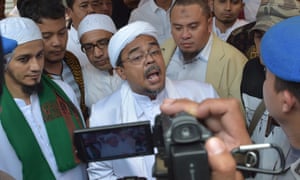
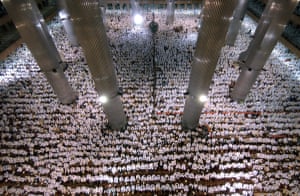
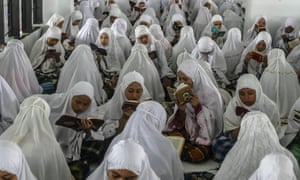
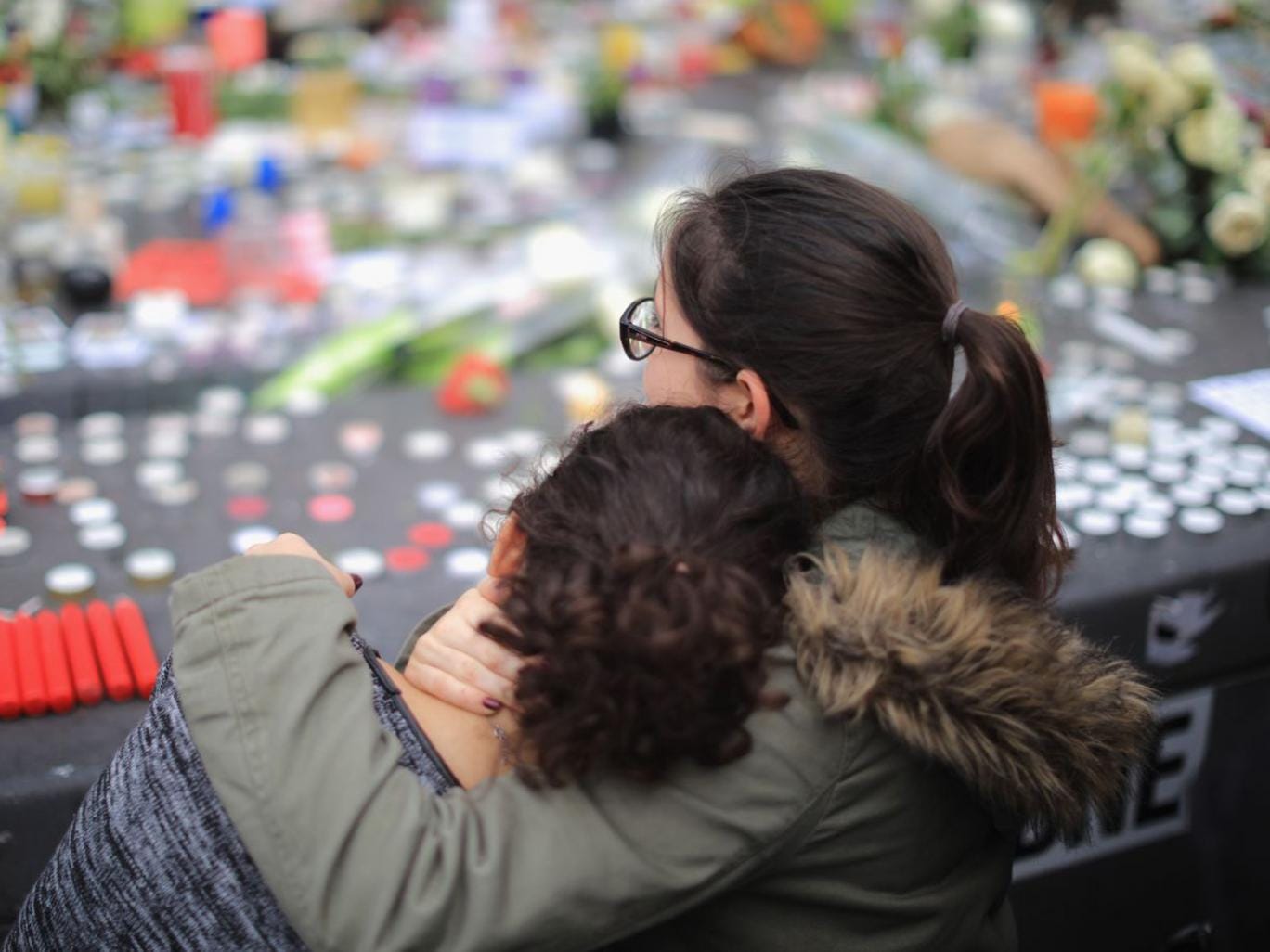 People weep as they gather to observe a minute-silence at the Place de la Republique in memory of the victims of the Paris terror attacksGetty
People weep as they gather to observe a minute-silence at the Place de la Republique in memory of the victims of the Paris terror attacksGetty




